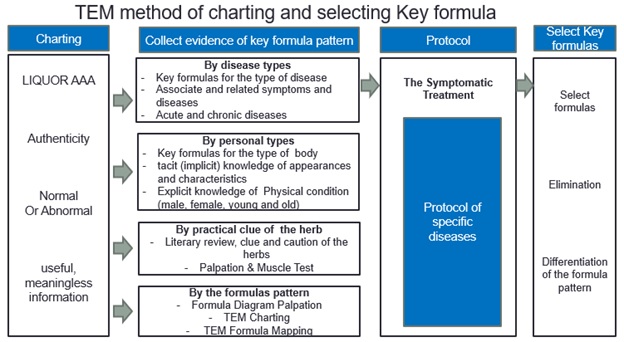
A Journey to Find the One Formula for the Symptoms You Want to Treat.
By Hyunchang Cho, L.Ac., Ph.D
I explained TEM (Traditional Eastern Medicine) formulas and how to find the most efficient formula for each symptom. It could be understood by a protocol to find the key formula by disease types.
For this month, I want to review the earlier content, and I will continue my theory.
First, disease types are important because my protocols for certain disorders or symptoms are standardized clinical guidelines for psychological disorders and musculoskeletal disorders.
Second, body type is the thing you should determine. Personal types consist of Tacit Knowledge of CAPE and Explicit Knowledge of TIOM. Some might be confused with the body type with Four Body Constitutional Medicine or Sasang typology, which is traditional Korean medicine developed by Yi, Je-ma in 1894.
1) Tacit knowledge and Explicit knowledge
Knowledge can be divided into tacit knowledge and explicit knowledge. Implicit or tacit knowledge is the knowledge embodied in an individual but is difficult to convey to others in words or writing.
e.g.) Riding a bicycle, hitting a golf ball well, training the Taegeukgwon, clinical sense of a skilled doctor.
On the other hand, explicit knowledge refers to the knowledge expressed in words or writings.
e.g.) Books or lectures.
Like the bottom of an iceberg that cannot be seen above, tacit knowledge such as the expertise of a skillful clinician accumulated through time and experience may be taught, but it inherently cannot guarantee successful transmission from the teacher to the student.
This is why Miyamoto Musashi, a swordsman who lived in the Japanese medieval period, left the famous saying, ‘One may teach, but cannot pass on.
In the clinical practice of TEM, an area of implicit knowledge exists. That’s why there’s a substantial gap between a good clinician and an average one that will always exist. But suppose we don’t convert the implicit knowledge from our clinical practice into knowledge that anyone can learn. In that case, our medicine will lack transferability, reproducibility, and objectivity, and therefore narrowing the gap between superior and inferior clinicians will be difficult.
So I’ve been working on transforming implicit knowledge of TEM into simple explicit knowledge that anyone can easily learn and acquire.
2) Tacit Knowledge of CAPE
Tacit knowledge of CAPE has been proven through TEM clinical experience and is consisted of △Color (facial Color) △ Appearance (body type/ Personality/ Emotion.)
The components that make up CAPE are as follows:
|
Appearance (=Body Type) |
obese/slim, harder/softer bodies, big-boned/small-boned, upper/lower body predominance (Yin/Yang body types), face shapes, strong/weak stamina, and such |
|
Color |
Darker complexions (black/brown/red hues) vs pale complexions (yellowish/white/bluish hues) |
|
Personality |
Personality can be divided into Yin/Yang/In-between(mixed) personalities, determined by slow/fast, strong/weak, introvert/extrovert, static/dynamic, loud/quiet voices. When determining Yin/Yang personality is difficult, we can also look into Yin/Yang body types, which refer to upper/lower body predominance |
|
Emotion |
Seven major emotion groups are ①Anger and excitement, ②nervousness and sensitiveness, ③worry, ④fear and jumpiness, ⑤anxiety, ⑥sorrow and oppression, ⑦depression |
The personality types of Yin/Yang and the seven emotions are called ‘Yin, Yang and Seven Emotions (陰陽七情).’ They are slightly different from Yin, Yang, and Seven Emotions of TCM. Under the TEM theories, Yin, Yang, facial color, and the seven emotions can be matched to the herbs listed below.
This is very important, so please take your time to study them before moving on.
|
Guiding Herb |
Yin/Yang |
Emotions |
|
Huang Lian |
Yang |
Anger and excitement |
|
Chai Hu |
Nervousness and sensitiveness |
|
|
Mu Li |
Anxiety |
|
|
Long Gu |
Yin |
Fear and anxiety |
|
Fu Ling |
Worry |
|
|
‘Xiang Chi + Zhi Zi’ |
Sorrow and oppression |
|
|
Zhi Shi |
Depression |
Next month, I will introduce the last technique to find a formula, TIOM, which stands for temperature, food intake and output, and mental status. Then, I will introduce thirty guiding herbs that lead you to find the key formula for your patient’s current symptoms.

































